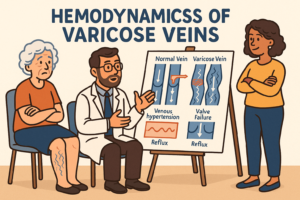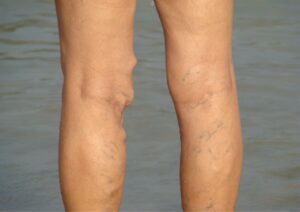Discover the truth about varicose vein stripping and why modern varicose vein treatment options offer superior results. Gone are the days of accepting invasive procedures as the only solution for varicose veins. In this article, we’ll uncover the outdated methods of varicose vein stripping and shed light on the advanced alternatives that are revolutionising vascular care. We’ll delve into the reasons why individuals are opting for these modern options and how they are proving to be more effective and less invasive. Whether you’re dealing with varicose veins or seeking insights into the latest advancements in vein treatment, this article will provide you with the knowledge you need to make informed decisions about your vascular health. Say goodbye to outdated treatments and embrace the new era of vein care.
Understanding vein stripping and its traditional approach
Vein stripping, also known as vein ligation and stripping, is a surgical procedure that has been utilised for decades to remove varicose veins. The traditional approach involves making incisions in the leg, locating and tying off the affected veins, and physically removing them from the body. While this method was once considered the standard treatment for varicose veins, its invasive nature and associated risks have led to the development of more advanced alternatives.
Despite being effective in some cases, vein stripping often resulted in significant post-operative pain, extended recovery periods, and a higher likelihood of complications such as blood clots, infection, nerve damage and varicose vein recurrence. Additionally, the cosmetic outcome of varicose vein surgery and stripping was not always satisfactory, as scarring and pigmentation changes were common. As a result, patients began seeking less invasive and more effective options for treating their varicose veins.
Limitations and drawbacks of varicose vein stripping and why you should avoid it
The limitations and drawbacks of vein stripping surgery became increasingly apparent as medical technology advanced. The invasive nature of the procedure, along with the associated risks and discomfort, led to a growing demand for alternative treatments. Patients were no longer willing to undergo extensive surgery with prolonged recovery times when more advanced and less invasive options were becoming available.
Moreover, vein stripping primarily addressed the visible varicose veins without targeting the underlying cause of the condition. This meant that the procedure did not always provide long-term relief, and many patients experienced a recurrence of varicose veins over time. As a result, medical professionals and patients alike began to explore modern alternatives that could offer superior results with fewer risks and a more comprehensive approach to vein treatment.
Modern alternatives to varicose vein stripping
The evolution of vein treatment has led to the development of modern alternatives to vein stripping that prioritise effectiveness, safety, and patient comfort. These alternatives are designed to address the underlying venous insufficiency that causes varicose veins, rather than simply removing the visible symptoms. Among the most prominent modern options are endovenous laser treatment (EVLT) and sclerotherapy, both of which have revolutionised the field of vascular care.
Endovenous laser treatment (EVLT) involves the use of targeted laser energy to seal the affected vein, rerouting blood flow from damaged veins to healthier vessels. This minimally invasive procedure is performed under local anesthesia and offers a shorter recovery time compared to traditional vein stripping. EVLT has gained popularity for its efficacy in treating varicose veins at their source, leading to improved long-term outcomes and minimal scarring.
Sclerotherapy is another effective alternative to vein stripping, particularly for smaller varicose veins and spider veins. This non-surgical procedure involves injecting a solution directly into the affected veins, causing them to collapse and eventually fade from view. Sclerotherapy is well-tolerated by patients and allows for immediate return to normal activities, making it a convenient option for individuals seeking quick and effective treatment for their vascular concerns.
Advantages of modern varicose veins treatments
The advantages of modern vein treatments over traditional vein stripping are numerous and significant. Patients who choose modern alternatives can expect reduced pain, faster recovery, and minimal scarring, leading to improved overall satisfaction with their treatment experience. Additionally, modern treatments address the underlying cause of varicose veins, reducing the likelihood of recurrence and providing long-term relief.
By embracing modern vein treatments, individuals can avoid the risks associated with invasive vein surgery, such as infection, nerve damage, and prolonged recovery periods. The advancements in vascular care have made it possible for patients to undergo treatment with confidence, knowing that they are receiving the most effective and least invasive options available. As a result, the demand for traditional vein stripping has steadily declined in favour of these modern alternatives.
Endovenous laser treatment (EVLT) as a non-invasive option
Endovenous laser treatment (EVLT) has emerged as a non-invasive and highly effective alternative to vein stripping for individuals seeking relief from varicose veins. This procedure is performed in an office setting, under local anesthesia, and typically takes less than an hour to complete. During the procedure, a thin laser fiber is inserted into the affected vein, delivering targeted energy to seal the vein shut.
The redirected blood flow through healthier veins alleviates the symptoms of venous insufficiency, such as pain, swelling, and discomfort. Following EVLT, patients can resume their normal activities immediately, with minimal downtime and no visible scarring. The long-term success of EVLT in treating varicose veins has made it a preferred choice for both patients and vein specialists, solidifying its position as a modern and superior alternative to vein stripping.
Sclerotherapy: Another effective alternative to vein stripping
Sclerotherapy has gained widespread popularity as an effective and minimally invasive treatment for large varicose veins and spider veins. This outpatient procedure involves the injection of a sclerosing agent directly into the affected veins, causing them to collapse and fade over time. Sclerotherapy is well-suited for individuals with smaller varicose veins and spider veins, offering a simple yet highly effective solution for visible vascular concerns.
The convenience and effectiveness of sclerotherapy have made it a preferred choice for patients seeking immediate and noticeable improvement in the appearance of their legs. With minimal discomfort and no downtime, individuals can undergo sclerotherapy and return to their daily activities without interruption, making it an attractive alternative to the invasive nature of traditional vein stripping.
Combining modern vein treatments for optimal results
In some cases, a combination of modern vein treatments may be recommended to achieve optimal results for individuals with complex venous insufficiency. By addressing both the larger underlying veins and the smaller visible vessels, vein specialists can provide comprehensive care that targets the full spectrum of vascular concerns. This approach allows for customised treatment plans that cater to the unique needs and goals of each patient.
Combining modern vein treatments, such as EVLT and sclerotherapy, can maximize the effectiveness of the overall treatment, leading to improved cosmetic outcomes and long-term relief. The ability to tailor treatment to each patient’s specific condition underscores the advancements in vascular care and the personalized approach that modern alternatives offer over the one-size-fits-all nature of traditional vein stripping.
Recovery and aftercare for modern vein treatments
The recovery and aftercare following modern vein treatments are significantly more manageable compared to traditional vein stripping. Patients can expect minimal discomfort, reduced downtime, and a swift return to their regular activities following procedures such as EVLT and sclerotherapy. Vein specialists provide detailed post-treatment instructions to ensure the best possible outcomes for their patients.
Aftercare may include wearing compression stockings, engaging in light physical activity, and attending follow-up appointments to monitor progress. By following these guidelines, patients can optimize the results of their treatment and experience a smooth and uneventful recovery. The streamlined recovery process associated with modern vein treatments further underscores their superiority over the dated approach of vein stripping.
Finding the right vein treatment specialist
When considering modern vein treatments, finding the right vein treatment specialist is crucial to ensuring a positive experience and optimal results. It is essential to seek out a doctor with extensive experience in modern vein treatments, as well as a track record of successful outcomes. A knowledgeable and skilled doctor can provide personalised care and guidance throughout the treatment process, addressing any concerns and tailoring the approach to meet individual needs.
Patients should also look for a practice that offers state-of-the-art facilities and a comprehensive range of modern vein treatments, demonstrating a commitment to delivering the latest advancements in vascular care. By choosing a reputable and experienced vein treatment doctor, individuals can feel confident in their decision to pursue modern alternatives rather than varicose vein stripping.
Conclusion: Embracing modern vein treatments for better results
In conclusion, the landscape of vein treatment has evolved significantly, offering modern alternatives to vein surgical stripping that prioritize effectiveness, safety, and patient comfort. Endovenous laser treatment (EVLT) and sclerotherapy have emerged as superior options for individuals seeking relief from varicose veins, providing minimal invasiveness, faster recovery, and long-term results. By embracing these modern vein treatments, individuals can avoid the limitations and risks associated with traditional vein stripping, and instead, experience comprehensive care that addresses the underlying cause of their vascular concerns.
The advancements in vascular care have empowered patients to make informed decisions about their vein treatment, leading to increased satisfaction and improved outcomes. As the demand for traditional vein stripping diminishes, the popularity of modern alternatives continues to rise, signalling a new era in vein care that prioritises patient well-being and superior results. Say goodbye to outdated treatments and embrace the new era of vein care by choosing modern vein treatments for a brighter and healthier vascular future.









